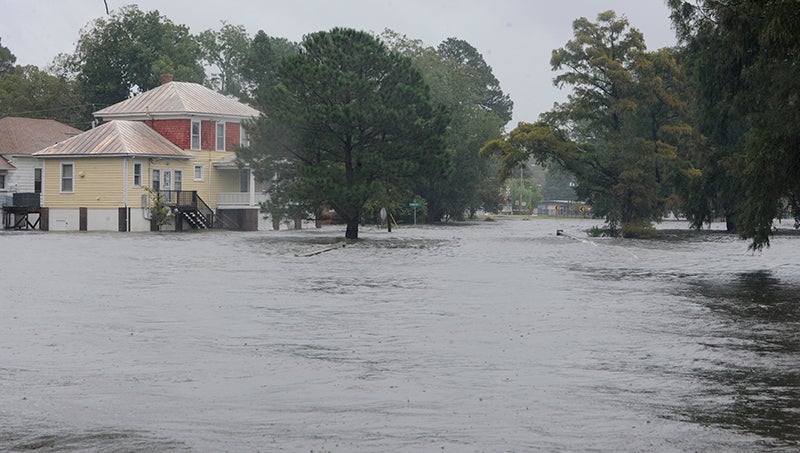Response, proactive measures focus from Florence to Dorian
Published 7:44 pm Tuesday, September 17, 2019

- ON THE RISE: Jack’s Creek and the Pamlico River merged at the end of East Main Street in Washington in the hours before Hurricane Florence hit eastern North Carolina in September 2018. (Ashley Vansant/Daily News)
This is the third in a series of articles about the year since Hurricane Florence hit Beaufort County on Sept. 14, 2018.
Hurricane Florence was a game changer. The category 1 storm hovered over eastern North Carolina for two days, pushing massive amounts of water into rivers and creeks, compounded by incessant rain, at times torrential. Homes never flooded before, flooded then. First responders made hundreds of water rescues.
A year later, the owners of some flooded homes are still displaced. A year later, emergency response has had time to reflect on the increase of proactive measures and work toward putting them in place.
“What was learned? My mind naturally thinks of both good and bad: good lessons and bad lessons,” said Chris Newkirk, chief of fire/emergency management for Beaufort County Emergency Services. “When Florence happened, both (BCES Director Carnie Hedgepeth) and I were new in our positions — we’d only been here for about a year — and we had made a lot of changes, to EOC (Emergency Operations Center), to departments. Florence was the first test run of those changes. We knew we had made changes in our minds, but it hadn’t really been tested yet.”
Over the course of the storm and its aftermath, a team of emergency responders from across the county and beyond, including swift water rescue teams from New Jersey and Arizona, who’d previously never tackled a natural disaster together, met each challenge, ironing out the kinks along the way, according to Newkirk.
“I would imagine it like an All-star game in football or baseball. They’re all great players on their own teams but you’ve never had them all on the same team together,” Newkirk said. “We knew we had the talent, we knew that on paper, we just hadn’t tested it.”
Weeks ago, as Dorian evolved into a threat to eastern North Carolina, Newkirk said, born from the Florence experience, there was cohesiveness, cooperation and communication from the first.
“It wasn’t the first time taking the field together,” he said.
In the year between the two storms, Emergency Services has focused not only on response, but on proactive measures.
“With emergency management, you have four phases: you have mitigation, preparedness, response and recovery. On the recovery piece, I would put our responders in our county against anybody in the state,” Newkirk said. “The response piece we are very good at. But if we could master the mitigation piece, we wouldn’t need the response. We do need to have that response piece and have our ability to respond to water incidents, and we’re continuing to do that, but when you think about it, would you rather respond or get ahead of it? Response is chasing the problem.”
Newkirk said the experience of Hurricane Irene in 2011 and the many mitigation projects that storm spawned — raising homes or buying out properties that have been severely flooded multiple times — has paid off, with regard to response.
“This has been a very aggressive county on mitigation. We had a lot of damaged houses from Florence — we did. But how many more would we have had if we hadn’t been working on mitigation for the previous four years?” Newkirk asked.
Getting ahead of response means making decisions earlier, from evacuation orders and opening shelters to requesting outside resources such as water rescue crews, even when it’s still too early to tell where a given hurricane’s path will take it.
“If you wait 48, 72 hours for that forecast you have confidence in, you’re too late to make those decisions you have to make,” Newkirk said. “It’s a challenge.”
On the county administrative side, the past year also has brought more effort to be proactive in response to storms that, while not necessarily increasing in intensity, have increased in size and longevity. Beaufort County commissioners invested in generators to keep the water flowing in the county water system on the south side of the river in case of power outages, according to Beaufort County manager Brian Alligood. The Board of Commissioners has also approved multiple grants that put more rescue equipment in the hands of first responders, as well as an unprecedented FEMA application to raise or buy out 87 properties suffering severe, repetitive flooding. The process of application to the state level first, then federal level, to approval and homes actually raised or bought out could take three years.
While Alligood said county response may not have changed much from Florence to Dorian, the approach has. Both Alligood and Newkirk agree it’s teamwork and proactive measures that count.
“There are a lot of folks who are a part of that team. There are a lot of players involved as we activate that EOC, and as they continue to work together, they just get better at it,” Alligood said.
“That’s our goal, is to make it better each time,” Newkirk said.





